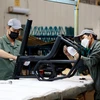As Vietnam continues to open up its insurance market further, allowing foreign non-life insurance companies to set up branches in the country, domestic firms will have to improve their act to cope with stronger competition, industry insiders say.
Phung Gia Loc, General Secretary of the Association of Vietnamese Insurers (AVI), said domestic non-life insurance companies will have to face more rivals with greater advantages this year.
Loc cited some of the advantages that foreign companies have, including having their cost accounting done at parent companies outside Vietnam , greater financial potential and an advertising budget not governed by Vietnamese regulations.
Meanwhile, among the weaknesses of local insurers, he said the most challenging is the lack of information, technology applications in customer management, including collection of premiums, and timely and accurate appraisals.
"In other countries, there are independent appraisal consultants as well as independent rescue institutions in other countries, while a local insurance company has to do all these things by itself, therefore their information handling is not as quick as it should be," he said.
Compensation procedures in Vietnam also more complicated and put local businesses at a disadvantage, he said.
Meanwhile, insurance companies in other countries offer good services and can also pay extra compensation as a goodwill gesture, he added.
Talking about market prospects, the AVI general secretary said that once the State reduces its stake in businesses so that the private sector has a larger one in the country's economy, the market will have a better environment for growth.
"In this context, businesses will be more willing to buy insurance as their responsibility will be closely linked to their assets" Loc said.
Last year the non-life insurance sector achieved a growth rate of around 25 percent, reaching a total premium turnover of 21.5 trillion VND (1 billion USD). The figure is expected to increase to 27.6 trillion VND (1.28 billion USD) this year, up 28 percent. /.
Phung Gia Loc, General Secretary of the Association of Vietnamese Insurers (AVI), said domestic non-life insurance companies will have to face more rivals with greater advantages this year.
Loc cited some of the advantages that foreign companies have, including having their cost accounting done at parent companies outside Vietnam , greater financial potential and an advertising budget not governed by Vietnamese regulations.
Meanwhile, among the weaknesses of local insurers, he said the most challenging is the lack of information, technology applications in customer management, including collection of premiums, and timely and accurate appraisals.
"In other countries, there are independent appraisal consultants as well as independent rescue institutions in other countries, while a local insurance company has to do all these things by itself, therefore their information handling is not as quick as it should be," he said.
Compensation procedures in Vietnam also more complicated and put local businesses at a disadvantage, he said.
Meanwhile, insurance companies in other countries offer good services and can also pay extra compensation as a goodwill gesture, he added.
Talking about market prospects, the AVI general secretary said that once the State reduces its stake in businesses so that the private sector has a larger one in the country's economy, the market will have a better environment for growth.
"In this context, businesses will be more willing to buy insurance as their responsibility will be closely linked to their assets" Loc said.
Last year the non-life insurance sector achieved a growth rate of around 25 percent, reaching a total premium turnover of 21.5 trillion VND (1 billion USD). The figure is expected to increase to 27.6 trillion VND (1.28 billion USD) this year, up 28 percent. /.



















